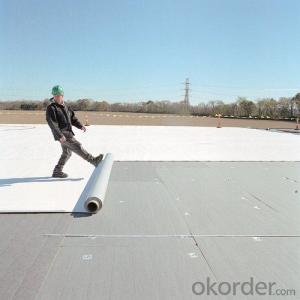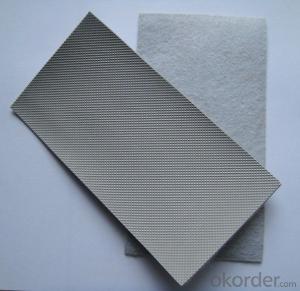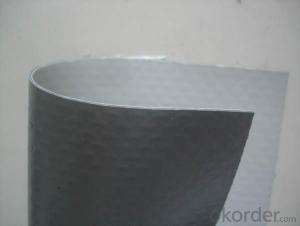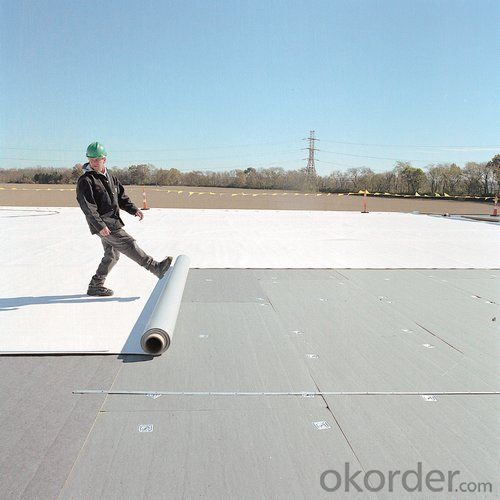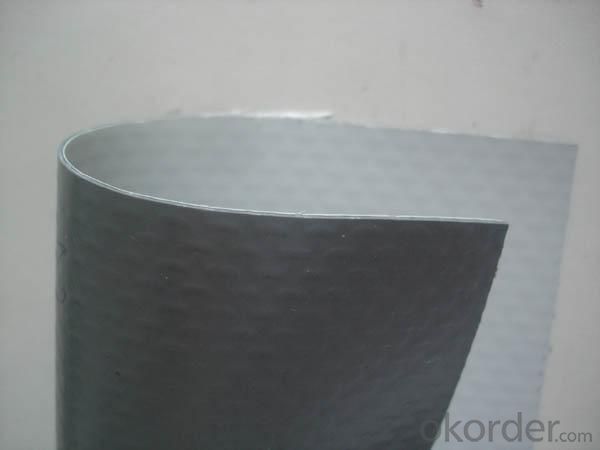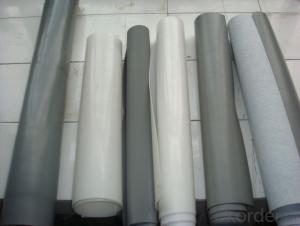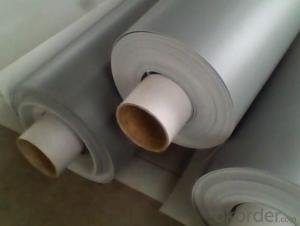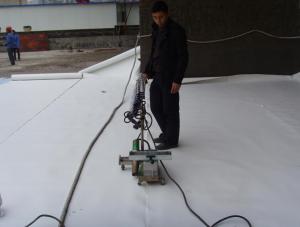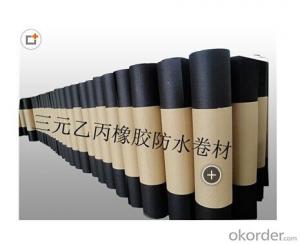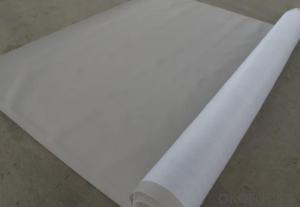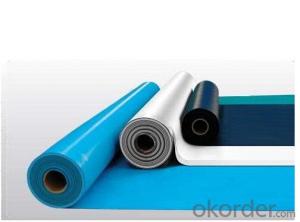PVC Roofing Waterproofing Membrane with UV Resistance
- Loading Port:
- China main port
- Payment Terms:
- TT OR LC
- Min Order Qty:
- 1000 m²
- Supply Capability:
- 50000 m²/month
OKorder Service Pledge
OKorder Financial Service
You Might Also Like
PVC roofing waterproof membrane with UV resistance
PVC membrane can be used for waterproofing on the steel roof, walking roof , planting roof, tunnel, basement, etc.
PVC membrane introduction:
Polyvinyl Chloride (PVC) membrane waterproof membrane is a kind of polymer compound
waterproof membrane compound of polyvinyl chloride colophony, plasticizer, stabilizing agent
,ultraviolet radiation(UV) resistance agent, all kinds of dyes and other agent.
1) Thickness: 0.3mm-2.0mm
2) Color: gray, green, blue
3.) Width: 2.0m
Polyvinyl chloride the pvc waterproofing plastic membrane is a kind of excellent performance of polymer waterproof material,PVC resin as the main raw material,add all kinds of special additive and anti-aging composition,the use of advanced equipment and advanced technology extrusion rolling is made.The product has the tensile strength and elongation high shrinkage of small,low temperature soft good,long life and other advantages, the products wide 1.2m to 3.0m, the thickness of 0.8-2.0 mm(special specifications can be customized),stable performance,reliable quality,construction is convenient.
Application Scope
The products are widely used in all kinds of civil construction,subway,tunnel,water conservancy,landfill site,chemical industry,metallurgy and other areas of waterproof seepage control,corrosion engineering.
Product Category
Single composite PVC waterproof materials
Double composite PVC waterproof board
Seperate PVC waterproof board
Some sticky type PVC waterproof materials
FAQ of PVC Waterproofing Membrane
a.Can we get some samples before place order?
Answer: We can send the free samples to you by freight collect.
b.How many years can your PVC membrane guarantee?
Answer: We will guarantee the quality for 5 years at least.
c.Which countries you ever export the product?
Answer: We export the PVC membrane to South Africa, Middle east and even European countries.
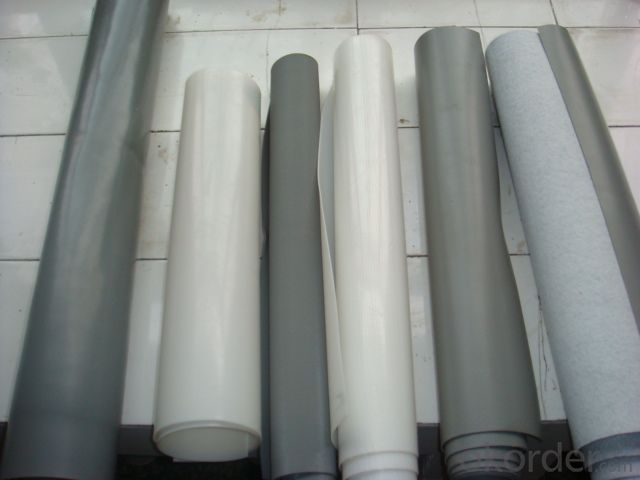
- Q: Can a waterproofing membrane be used for a planter box?
- Indeed, a planter box can benefit from the use of a waterproofing membrane. The primary function of a waterproofing membrane is to impede the intrusion of water into the surface it is applied to. Consequently, it is a suitable choice for safeguarding the planter box against moisture-induced harm. By employing a waterproofing membrane on the interior of the planter box, a barrier is established that thwarts the infiltration of water and the potential harm it may inflict upon the wood or material of the planter box. This can prove particularly advantageous when the planter box is persistently exposed to water, such as in outdoor settings or for hydroponic gardening endeavors. In essence, the utilization of a waterproofing membrane for a planter box can contribute to its longevity and ensure its sustained good condition.
- Q: Can a waterproofing membrane be used for tunnels and subway stations?
- Yes, a waterproofing membrane can be used for tunnels and subway stations. Waterproofing membranes are designed to prevent the ingress of water and moisture into structures, making them an ideal solution for underground spaces such as tunnels and subway stations that are prone to water infiltration. These membranes are typically made of high-quality materials such as bitumen or synthetic polymers, which have excellent water-resistant properties. Using a waterproofing membrane in tunnels and subway stations provides several benefits. Firstly, it helps to protect the structural integrity of the underground infrastructure by preventing water from seeping into the concrete or other building materials. This can help to prevent corrosion and degradation of the structure, ensuring its longevity and safety. Secondly, a waterproofing membrane helps to maintain a dry and comfortable environment within the tunnels and subway stations. It prevents water from accumulating, which can lead to the growth of mold, mildew, and other harmful microorganisms. Additionally, it helps to control humidity levels, reducing the risk of condensation and water damage to equipment, electrical systems, and other components. Furthermore, waterproofing membranes can also act as a barrier against the ingress of external contaminants such as pollutants, chemicals, and gases. This is particularly important in subway stations, where there may be a higher concentration of pollutants from train exhaust and other sources. Overall, using a waterproofing membrane in tunnels and subway stations is a crucial step in ensuring the durability, safety, and comfort of these underground structures. It provides an effective solution for preventing water infiltration, protecting the infrastructure, and maintaining a dry and healthy environment for passengers and staff.
- Q: Can a waterproofing membrane be applied on top of existing waterproofing systems?
- Yes, a waterproofing membrane can be applied on top of existing waterproofing systems. In some cases, there may be a need to add an additional layer of protection or enhance the existing waterproofing system. Applying a new waterproofing membrane on top can provide an extra barrier against water penetration and help extend the lifespan of the waterproofing system. It is important to ensure proper preparation of the existing surface before applying the new membrane to ensure good adhesion and effectiveness. Additionally, consulting with a professional or manufacturer's guidelines can provide specific recommendations for the compatibility and application process of the new waterproofing membrane.
- Q: Can a waterproofing membrane be used for a basement?
- Basements can indeed benefit from the use of a waterproofing membrane. It is highly recommended to employ this method in order to avoid water infiltration and the accumulation of moisture. A waterproofing membrane consists of a thin layer of material that is applied to the walls and floor of the basement, serving as a barrier against water. This layer acts as a protective shield, preventing water from penetrating the walls and causing harm to the foundation and interior of the basement. Furthermore, the use of a waterproofing membrane can also decrease the likelihood of mold and mildew growth, as it maintains a dry and moisture-free environment in the basement. In conclusion, the utilization of a waterproofing membrane is an effective remedy for ensuring waterproof basements and providing a safe and dry living space.
- Q: Are waterproofing membranes resistant to sulfuric acid exposure?
- Waterproofing membranes are generally not resistant to sulfuric acid exposure. Sulfuric acid is a highly corrosive substance that can cause severe damage to many materials, including waterproofing membranes. Due to the strong acidic nature of sulfuric acid, it can react with and degrade the membrane, leading to its failure. Therefore, if there is a possibility of sulfuric acid exposure, it is important to use acid-resistant materials specifically designed to withstand such corrosive substances.
- Q: Can a waterproofing membrane be used on underground parking structures?
- Using a waterproofing membrane on underground parking structures is indeed recommended. This is because these structures are at risk of water infiltration due to their below-ground location and proximity to the water table. To prevent water from seeping into the structure and causing damage, a waterproofing membrane acts as a barrier. It safeguards against issues such as deterioration, corrosion, and the growth of mold. By maintaining the structural integrity of the parking facility, it extends its lifespan. Moreover, a properly installed waterproofing membrane can also protect against other sources of moisture, such as rainwater runoff or groundwater. Ultimately, it is crucial to use a waterproofing membrane to ensure the long-term durability and functionality of underground parking structures.
- Q: Can a waterproofing membrane be used in commercial buildings?
- Indeed, it is possible to utilize a waterproofing membrane in commercial establishments. Waterproofing membranes serve the purpose of safeguarding diverse sections of a building, encompassing roofs, foundations, and basements, against water infiltration. In the case of commercial buildings, where the likelihood of water harm is heightened due to larger surface areas, increased foot traffic, and intricate architectural designs, waterproofing membranes prove to be a viable solution. These membranes are specially crafted to establish a protective barrier against water, thereby averting leaks, moisture, and potential structural harm. Furthermore, the integration of waterproofing membranes contributes to the longevity of the building by reducing the risk of deterioration resulting from exposure to water. Consequently, the incorporation of a waterproofing membrane system in commercial establishments aids in maintaining a secure and dry environment, safeguarding valuable assets, and optimizing the lifespan of the structure.
- Q: Can a waterproofing membrane be used for a foundation wall?
- Yes, a waterproofing membrane can be used for a foundation wall. Waterproofing membranes are commonly used to prevent water infiltration and moisture issues in below-grade structures such as basements and foundation walls. These membranes act as a barrier to protect the foundation from water damage, helping to keep the interior of the building dry and preventing structural problems caused by moisture.
- Q: Can a waterproofing membrane prevent leaks from occurring?
- Preventing leaks is indeed possible with the use of a waterproofing membrane. This membrane is a thin material layer that, when applied to a surface, renders it completely impervious to water. Its purpose is to serve as a barrier, effectively stopping water from seeping through and causing any leaks. With correct installation and ongoing maintenance, a waterproofing membrane can provide reliable protection against water damage for a variety of structures, such as roofs, basements, bathrooms, and foundations. It is specifically designed to withstand the forces of nature, including rain, snow, and moisture, thus greatly reducing the likelihood of leaks and water infiltration. However, it is worth noting that the efficacy of a waterproofing membrane also relies on the quality of the product, proper installation procedures, and regular maintenance.
- Q: Can a waterproofing membrane be used on both interior and exterior surfaces of a structure?
- Yes, a waterproofing membrane can be used on both interior and exterior surfaces of a structure. It is designed to create a barrier that prevents water penetration, whether it is applied on the inside or outside of a building.
Send your message to us
PVC Roofing Waterproofing Membrane with UV Resistance
- Loading Port:
- China main port
- Payment Terms:
- TT OR LC
- Min Order Qty:
- 1000 m²
- Supply Capability:
- 50000 m²/month
OKorder Service Pledge
OKorder Financial Service
Similar products
Hot products
Hot Searches
Related keywords
